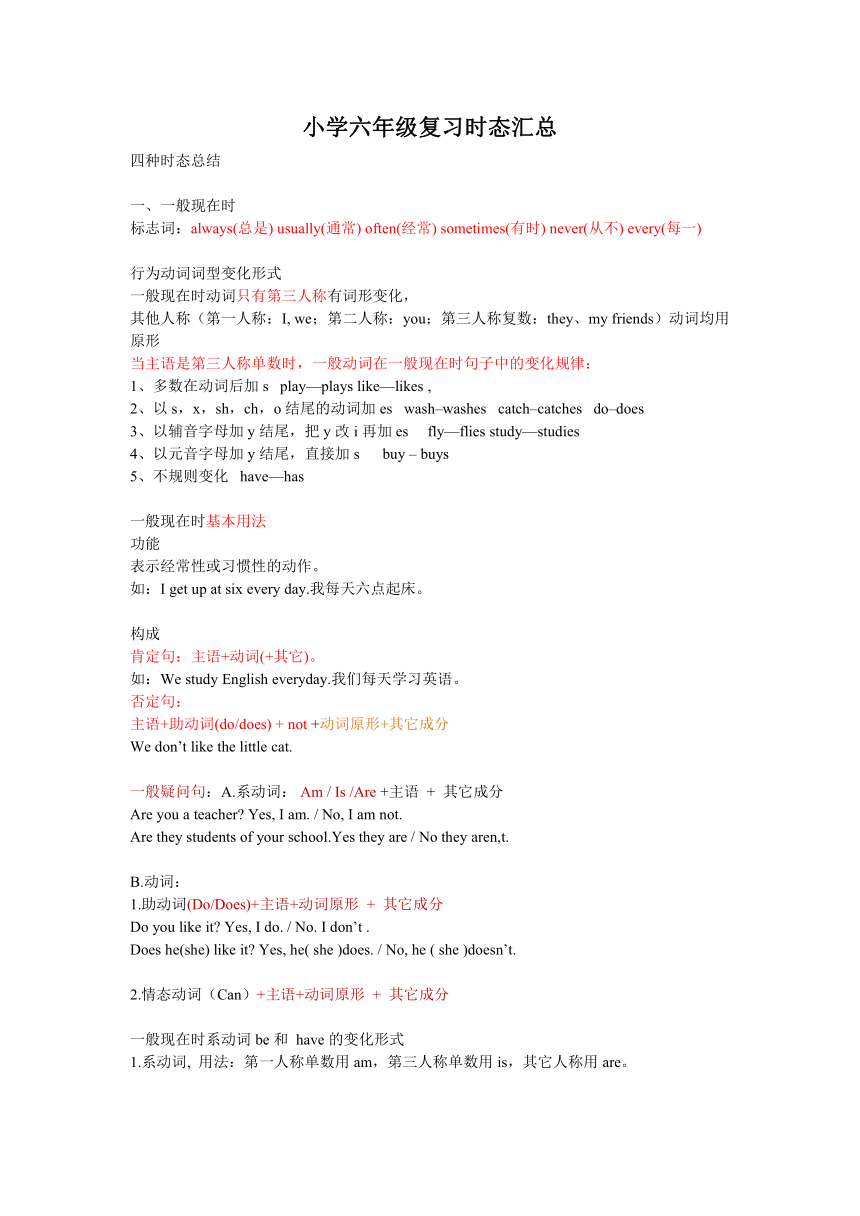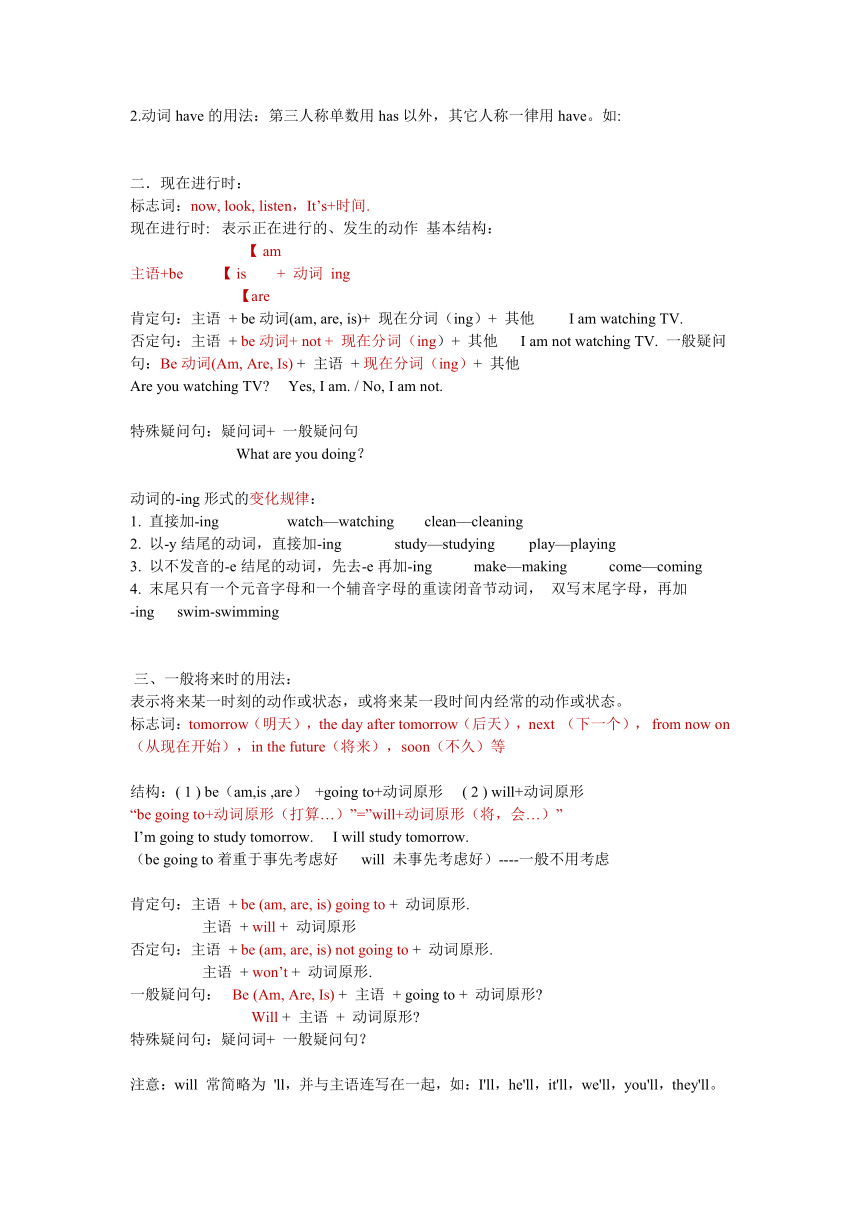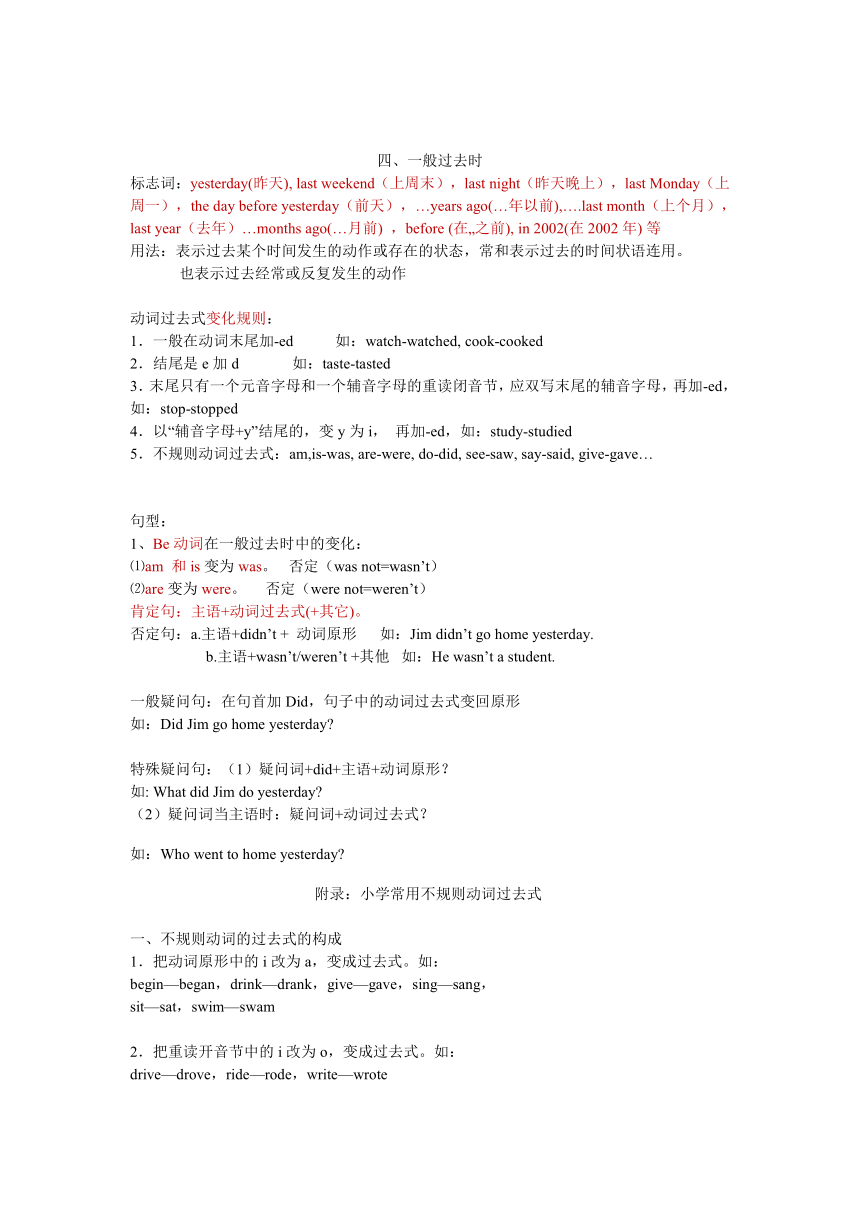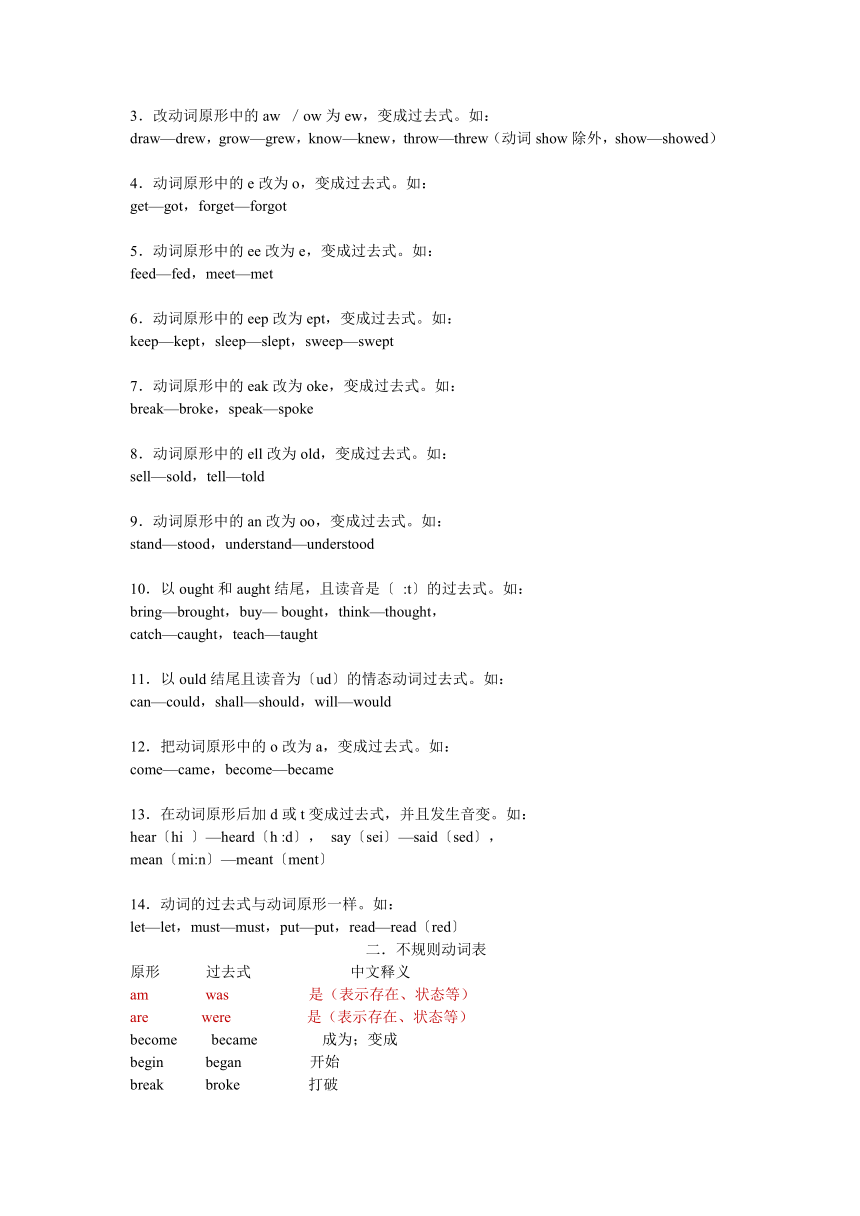小升初复习专题——时态专项汇总
图片预览




文档简介
小学六年级复习时态汇总
四种时态总结
一、一般现在时
标志词:always(总是) usually(通常) often(经常) sometimes(有时) never(从不) every(每一)
行为动词词型变化形式
一般现在时动词只有第三人称有词形变化,
其他人称(第一人称:I, we;第二人称:you;第三人称复数:they、my friends)动词均用原形
当主语是第三人称单数时,一般动词在一般现在时句子中的变化规律:
1、多数在动词后加s play—plays like—likes ,
2、以s,x,sh,ch,o结尾的动词加es wash–washes catch–catches do–does
3、以辅音字母加y结尾,把y改i再加es fly—flies study—studies
4、以元音字母加y结尾,直接加s buy – buys
5、不规则变化 have—has
一般现在时基本用法
功能
表示经常性或习惯性的动作。
如:I get up at six every day.我每天六点起床。
构成
肯定句:主语+动词(+其它)。
如:We study English everyday.我们每天学习英语。
否定句:
主语+助动词(do/does) + not +动词原形+其它成分
We don’t like the little cat.
一般疑问句:A.系动词: Am / Is /Are +主语 + 其它成分
Are you a teacher Yes, I am. / No, I am not.
Are they students of your school.Yes they are / No they aren,t.
B.动词:
1.助动词(Do/Does)+主语+动词原形 + 其它成分
Do you like it Yes, I do. / No. I don’t .
Does he(she) like it Yes, he( she )does. / No, he ( she )doesn’t.
2.情态动词(Can)+主语+动词原形 + 其它成分
一般现在时系动词be和 have的变化形式
1.系动词, 用法:第一人称单数用am,第三人称单数用is,其它人称用are。
2.动词have的用法:第三人称单数用has以外,其它人称一律用have。如:
二.现在进行时:
标志词:now, look, listen,It’s+时间.
现在进行时: 表示正在进行的、发生的动作 基本结构:
【 am
主语+be 【 is + 动词 ing
【are
肯定句:主语 + be动词(am, are, is)+ 现在分词(ing)+ 其他 I am watching TV.
否定句:主语 + be动词+ not + 现在分词(ing)+ 其他 I am not watching TV. 一般疑问句:Be动词(Am, Are, Is) + 主语 + 现在分词(ing)+ 其他
Are you watching TV Yes, I am. / No, I am not.
特殊疑问句:疑问词+ 一般疑问句
What are you doing?
动词的-ing形式的变化规律:
1. 直接加-ing watch—watching clean—cleaning
2. 以-y结尾的动词,直接加-ing study—studying play—playing
3. 以不发音的-e结尾的动词,先去-e再加-ing make—making come—coming
4. 末尾只有一个元音字母和一个辅音字母的重读闭音节动词, 双写末尾字母,再加-ing swim-swimming
三、一般将来时的用法:
表示将来某一时刻的动作或状态,或将来某一段时间内经常的动作或状态。
标志词:tomorrow(明天),the day after tomorrow(后天),next (下一个), from now on(从现在开始),in the future(将来),soon(不久)等
结构:( 1 ) be(am,is ,are) +going to+动词原形 ( 2 ) will+动词原形
“be going to+动词原形(打算…)”=”will+动词原形(将,会…)”
I’m going to study tomorrow. I will study tomorrow.
(be going to着重于事先考虑好 will 未事先考虑好)----一般不用考虑
肯定句:主语 + be (am, are, is) going to + 动词原形.
主语 + will + 动词原形
否定句:主语 + be (am, are, is) not going to + 动词原形.
主语 + won’t + 动词原形.
一般疑问句: Be (Am, Are, Is) + 主语 + going to + 动词原形
Will + 主语 + 动词原形
特殊疑问句:疑问词+ 一般疑问句?
注意:will 常简略为 'll,并与主语连写在一起,如:I'll,he'll,it'll,we'll,you'll,they'll。
四、一般过去时
标志词:yesterday(昨天), last weekend(上周末),last night(昨天晚上),last Monday(上周一),the day before yesterday(前天),…years ago(…年以前),….last month(上个月),last year(去年)…months ago(…月前) ,before (在 之前), in 2002(在2002年) 等
用法:表示过去某个时间发生的动作或存在的状态,常和表示过去的时间状语连用。
也表示过去经常或反复发生的动作
动词过去式变化规则:
1.一般在动词末尾加-ed 如:watch-watched, cook-cooked
2.结尾是e加d 如:taste-tasted
3.末尾只有一个元音字母和一个辅音字母的重读闭音节,应双写末尾的辅音字母,再加-ed,如:stop-stopped
4.以“辅音字母+y”结尾的,变y为i, 再加-ed,如:study-studied
5.不规则动词过去式:am,is-was, are-were, do-did, see-saw, say-said, give-gave…
句型:
1、Be动词在一般过去时中的变化:
⑴am 和is 变为was。 否定(was not=wasn’t)
⑵are 变为were。 否定(were not=weren’t)
肯定句:主语+动词过去式(+其它)。
否定句:a.主语+didn’t + 动词原形 如:Jim didn’t go home yesterday.
b.主语+wasn’t/weren’t +其他 如:He wasn’t a student.
一般疑问句:在句首加Did,句子中的动词过去式变回原形
如:Did Jim go home yesterday
特殊疑问句:(1)疑问词+did+主语+动词原形?
如: What did Jim do yesterday
(2)疑问词当主语时:疑问词+动词过去式?
如:Who went to home yesterday
附录:小学常用不规则动词过去式
一、不规则动词的过去式的构成
1.把动词原形中的i改为a,变成过去式。如:
begin—began,drink—drank,give—gave,sing—sang,
sit—sat,swim—swam
2.把重读开音节中的i改为o,变成过去式。如:
drive—drove,ride—rode,write—wrote
3.改动词原形中的aw /ow为ew,变成过去式。如:
draw—drew,grow—grew,know—knew,throw—threw(动词show除外,show—showed)
4.动词原形中的e改为o,变成过去式。如:
get—got,forget—forgot
5.动词原形中的ee改为e,变成过去式。如:
feed—fed,meet—met
6.动词原形中的eep改为ept,变成过去式。如:
keep—kept,sleep—slept,sweep—swept
7.动词原形中的eak改为oke,变成过去式。如:
break—broke,speak—spoke
8.动词原形中的ell改为old,变成过去式。如:
sell—sold,tell—told
9.动词原形中的an改为oo,变成过去式。如:
stand—stood,understand—understood
10.以ought和aught结尾,且读音是〔 :t〕的过去式。如:
bring—brought,buy— bought,think—thought,
catch—caught,teach—taught
11.以ould结尾且读音为〔ud〕的情态动词过去式。如:
can—could,shall—should,will—would
12.把动词原形中的o改为a,变成过去式。如:
come—came,become—became
13.在动词原形后加d或t变成过去式,并且发生音变。如:
hear〔hi 〕—heard〔h :d〕, say〔sei〕—said〔sed〕,
mean〔mi:n〕—meant〔ment〕
14.动词的过去式与动词原形一样。如:
let—let,must—must,put—put,read—read〔red〕
二.不规则动词表
原形 过去式 中文释义
am was 是(表示存在、状态等)
are were 是(表示存在、状态等)
become became 成为;变成
begin began 开始
break broke 打破
bring brought 拿来;取来;带来
build built 构筑;建造;建筑
buy bought 购买;买
can could 可以;能;可能;会
catch caught 赶上(车船等);捕获
come came 来;来到
cut cut 切;割;削;剪
do/does did 做;干;行动
draw drew 画
drink drank 喝;饮
drive drove 开车;驾驶
eat ate 吃
feel felt 感到;觉得
find found 寻找;查找
fly flew 飞行
forget forgot 忘记;忘却
get got 变得
give gave 给;授予
go went 去
have/has had 得(病);患(病);有;吃;饮
hear heard 听见;听说
hide hid 隐藏
is was 是(表示存在、状态等)
keep kept 保持;使保持某种状态
know knew 知道;了解
leave left 离去;出发
let let 允许;让
lose lost 失去;丧失
make made 使;促使;迫使;做;制作
may might 可能;可以
mean meant 表示 的意思;作 的解释
meet met 遇见;相逢
put put 放;摆;装
read read /e/ 读;阅读
ride rode 骑
ring rang (铃)响
rise rose 上升
run ran 跑;奔跑
say said 说;讲
see saw 看见
send sent 发送;寄;派;遣
set set 放, 置
show showed 出示;给 看
shut shut 关上(门、盖、窗户等)
sing sang 唱;唱歌
sit sat 坐
sleep slept 睡;睡觉
speak spoke 说;说话
swim swam 游泳
take took 搭乘;花费(时间);拿走;带到
teach taught 教;讲授
tell told 告诉;讲述
think thought 想;思考
will would 将要
win won 赢;获胜
write wrote 书写
一般过去时
一般过去时表示过去某个时间发生的动作或存在的状态,常和表示过去的时间状语如,yesterday, last..., just then, ...ago, in 1937等连用。
一般过去时也表示过去经常或反复发生的动作。
一般过去时中,动词要用过去式,动词原形变为它们的过去式,有以下五种情况:
直接在动词原形(V/do)后加-ed:
看望,拜访visit
展览,展示show
走路,步行walk
看,看起来look
大喊shout
指,指向point
笑,大笑laugh
想want
摘,采pick
变成turn
下雨rain
玩,打play
爬climb
观看watch
打电话call
听listen
问ask
发明invent
帮助help
二,以不发音字母“e”结尾,直接加-d:
喜欢like
住,居住live
使用,利用use
以“辅音字母+y”结尾,变“y”为“i”,再加-ed:
学习study
哭cry
搬carry
四,有些动词要双写最后一个字母,再加-ed:
停stop
旅行travel
计划plan
五,不规则动词的变化形式要记牢:
am/is was
are were
do did
能,可以can could
收到,接到get got
说say said
讲,叙述tell told
去go went
看见see saw
变为/成become became
来come came
飞fly flew
带来bring brought
带走,拿走take took
丢失lose lost
发现find found
有have had
抓catch caught
吃eat ate
买buy bought
使……变得,制作make made
读,看read read
写write wrote
穿wear wore
醒来wake woke
让let let
咬bite bit
给give gave
击,打hit hit
小学英语语法(词性)总结
一、形容词、副词的比较级和最高级的用法:
当两种物体之间相互比较时,我们要用形容词或副词的比较级;当相互比较的物体是三个或三个以上时,用形容词或副词的最高级。
比较级
二者比较,标志词:than
最高级
三者以上比较,标志词:the
形容词、副词的比较级和最高级的变化规律:
1. 单音节形容词或副词后面直接加-er或-est
tall—taller—tallest fast—faster—fastest
2. 以-e结尾的单音节形容词或副词直接加-r或-st
large—larger—largest nice—nicer—nicest
3. 以-y结尾的形容词或副词,改-y为-i再加-er或-est
busy—busier—busiest early—earlier—earliest
4. 形容词或副词是重读闭音节时,双写最后的辅音字母,再加-er或-est
hot—hotter—hottest
5. 多音节形容词或副词前面直接加more或most
beautiful—more beautiful—most beautiful
6. 以ly结尾的副词一般加more或most
slowly—more slowly—most slowly
7. 不规则变化 good (well)- better-best bad (badly)-worse-worst
little-less-least far-farther-further
many(much)- more – most
形容词、副词的比较级和最高级用法:
比较级:
1、形容词:物体A + am / are / is + 形容词比较级 + than + 物体B
I am taller than you. This picture is more beautiful than that one.
2、副词:物体A + 动词(原型、单三) + 副词比较级 + than + 物体B.
He studies better than me.
最高级:
1、形容词:物体A + am / are / is + the + 形容词最高级 + 比较范围(of + 人/物,in + 地方).
I am the tallest in the class. Shanghai is one of the biggest cities in China.
2、副词:物体A + 动词(原型、单三) + 副词最高级 + 比较范围(of + 人/物,in + 地方).
Cheetahs run fastest in the world. He studies best of us.
表示两者对比相同:主语+谓语+as+形容词/副词原形+as+从句
This box is as big as mine. This coat is not so/as cheap as that one.
I study English as hard as my brother.
四种时态总结
一、一般现在时
标志词:always(总是) usually(通常) often(经常) sometimes(有时) never(从不) every(每一)
行为动词词型变化形式
一般现在时动词只有第三人称有词形变化,
其他人称(第一人称:I, we;第二人称:you;第三人称复数:they、my friends)动词均用原形
当主语是第三人称单数时,一般动词在一般现在时句子中的变化规律:
1、多数在动词后加s play—plays like—likes ,
2、以s,x,sh,ch,o结尾的动词加es wash–washes catch–catches do–does
3、以辅音字母加y结尾,把y改i再加es fly—flies study—studies
4、以元音字母加y结尾,直接加s buy – buys
5、不规则变化 have—has
一般现在时基本用法
功能
表示经常性或习惯性的动作。
如:I get up at six every day.我每天六点起床。
构成
肯定句:主语+动词(+其它)。
如:We study English everyday.我们每天学习英语。
否定句:
主语+助动词(do/does) + not +动词原形+其它成分
We don’t like the little cat.
一般疑问句:A.系动词: Am / Is /Are +主语 + 其它成分
Are you a teacher Yes, I am. / No, I am not.
Are they students of your school.Yes they are / No they aren,t.
B.动词:
1.助动词(Do/Does)+主语+动词原形 + 其它成分
Do you like it Yes, I do. / No. I don’t .
Does he(she) like it Yes, he( she )does. / No, he ( she )doesn’t.
2.情态动词(Can)+主语+动词原形 + 其它成分
一般现在时系动词be和 have的变化形式
1.系动词, 用法:第一人称单数用am,第三人称单数用is,其它人称用are。
2.动词have的用法:第三人称单数用has以外,其它人称一律用have。如:
二.现在进行时:
标志词:now, look, listen,It’s+时间.
现在进行时: 表示正在进行的、发生的动作 基本结构:
【 am
主语+be 【 is + 动词 ing
【are
肯定句:主语 + be动词(am, are, is)+ 现在分词(ing)+ 其他 I am watching TV.
否定句:主语 + be动词+ not + 现在分词(ing)+ 其他 I am not watching TV. 一般疑问句:Be动词(Am, Are, Is) + 主语 + 现在分词(ing)+ 其他
Are you watching TV Yes, I am. / No, I am not.
特殊疑问句:疑问词+ 一般疑问句
What are you doing?
动词的-ing形式的变化规律:
1. 直接加-ing watch—watching clean—cleaning
2. 以-y结尾的动词,直接加-ing study—studying play—playing
3. 以不发音的-e结尾的动词,先去-e再加-ing make—making come—coming
4. 末尾只有一个元音字母和一个辅音字母的重读闭音节动词, 双写末尾字母,再加-ing swim-swimming
三、一般将来时的用法:
表示将来某一时刻的动作或状态,或将来某一段时间内经常的动作或状态。
标志词:tomorrow(明天),the day after tomorrow(后天),next (下一个), from now on(从现在开始),in the future(将来),soon(不久)等
结构:( 1 ) be(am,is ,are) +going to+动词原形 ( 2 ) will+动词原形
“be going to+动词原形(打算…)”=”will+动词原形(将,会…)”
I’m going to study tomorrow. I will study tomorrow.
(be going to着重于事先考虑好 will 未事先考虑好)----一般不用考虑
肯定句:主语 + be (am, are, is) going to + 动词原形.
主语 + will + 动词原形
否定句:主语 + be (am, are, is) not going to + 动词原形.
主语 + won’t + 动词原形.
一般疑问句: Be (Am, Are, Is) + 主语 + going to + 动词原形
Will + 主语 + 动词原形
特殊疑问句:疑问词+ 一般疑问句?
注意:will 常简略为 'll,并与主语连写在一起,如:I'll,he'll,it'll,we'll,you'll,they'll。
四、一般过去时
标志词:yesterday(昨天), last weekend(上周末),last night(昨天晚上),last Monday(上周一),the day before yesterday(前天),…years ago(…年以前),….last month(上个月),last year(去年)…months ago(…月前) ,before (在 之前), in 2002(在2002年) 等
用法:表示过去某个时间发生的动作或存在的状态,常和表示过去的时间状语连用。
也表示过去经常或反复发生的动作
动词过去式变化规则:
1.一般在动词末尾加-ed 如:watch-watched, cook-cooked
2.结尾是e加d 如:taste-tasted
3.末尾只有一个元音字母和一个辅音字母的重读闭音节,应双写末尾的辅音字母,再加-ed,如:stop-stopped
4.以“辅音字母+y”结尾的,变y为i, 再加-ed,如:study-studied
5.不规则动词过去式:am,is-was, are-were, do-did, see-saw, say-said, give-gave…
句型:
1、Be动词在一般过去时中的变化:
⑴am 和is 变为was。 否定(was not=wasn’t)
⑵are 变为were。 否定(were not=weren’t)
肯定句:主语+动词过去式(+其它)。
否定句:a.主语+didn’t + 动词原形 如:Jim didn’t go home yesterday.
b.主语+wasn’t/weren’t +其他 如:He wasn’t a student.
一般疑问句:在句首加Did,句子中的动词过去式变回原形
如:Did Jim go home yesterday
特殊疑问句:(1)疑问词+did+主语+动词原形?
如: What did Jim do yesterday
(2)疑问词当主语时:疑问词+动词过去式?
如:Who went to home yesterday
附录:小学常用不规则动词过去式
一、不规则动词的过去式的构成
1.把动词原形中的i改为a,变成过去式。如:
begin—began,drink—drank,give—gave,sing—sang,
sit—sat,swim—swam
2.把重读开音节中的i改为o,变成过去式。如:
drive—drove,ride—rode,write—wrote
3.改动词原形中的aw /ow为ew,变成过去式。如:
draw—drew,grow—grew,know—knew,throw—threw(动词show除外,show—showed)
4.动词原形中的e改为o,变成过去式。如:
get—got,forget—forgot
5.动词原形中的ee改为e,变成过去式。如:
feed—fed,meet—met
6.动词原形中的eep改为ept,变成过去式。如:
keep—kept,sleep—slept,sweep—swept
7.动词原形中的eak改为oke,变成过去式。如:
break—broke,speak—spoke
8.动词原形中的ell改为old,变成过去式。如:
sell—sold,tell—told
9.动词原形中的an改为oo,变成过去式。如:
stand—stood,understand—understood
10.以ought和aught结尾,且读音是〔 :t〕的过去式。如:
bring—brought,buy— bought,think—thought,
catch—caught,teach—taught
11.以ould结尾且读音为〔ud〕的情态动词过去式。如:
can—could,shall—should,will—would
12.把动词原形中的o改为a,变成过去式。如:
come—came,become—became
13.在动词原形后加d或t变成过去式,并且发生音变。如:
hear〔hi 〕—heard〔h :d〕, say〔sei〕—said〔sed〕,
mean〔mi:n〕—meant〔ment〕
14.动词的过去式与动词原形一样。如:
let—let,must—must,put—put,read—read〔red〕
二.不规则动词表
原形 过去式 中文释义
am was 是(表示存在、状态等)
are were 是(表示存在、状态等)
become became 成为;变成
begin began 开始
break broke 打破
bring brought 拿来;取来;带来
build built 构筑;建造;建筑
buy bought 购买;买
can could 可以;能;可能;会
catch caught 赶上(车船等);捕获
come came 来;来到
cut cut 切;割;削;剪
do/does did 做;干;行动
draw drew 画
drink drank 喝;饮
drive drove 开车;驾驶
eat ate 吃
feel felt 感到;觉得
find found 寻找;查找
fly flew 飞行
forget forgot 忘记;忘却
get got 变得
give gave 给;授予
go went 去
have/has had 得(病);患(病);有;吃;饮
hear heard 听见;听说
hide hid 隐藏
is was 是(表示存在、状态等)
keep kept 保持;使保持某种状态
know knew 知道;了解
leave left 离去;出发
let let 允许;让
lose lost 失去;丧失
make made 使;促使;迫使;做;制作
may might 可能;可以
mean meant 表示 的意思;作 的解释
meet met 遇见;相逢
put put 放;摆;装
read read /e/ 读;阅读
ride rode 骑
ring rang (铃)响
rise rose 上升
run ran 跑;奔跑
say said 说;讲
see saw 看见
send sent 发送;寄;派;遣
set set 放, 置
show showed 出示;给 看
shut shut 关上(门、盖、窗户等)
sing sang 唱;唱歌
sit sat 坐
sleep slept 睡;睡觉
speak spoke 说;说话
swim swam 游泳
take took 搭乘;花费(时间);拿走;带到
teach taught 教;讲授
tell told 告诉;讲述
think thought 想;思考
will would 将要
win won 赢;获胜
write wrote 书写
一般过去时
一般过去时表示过去某个时间发生的动作或存在的状态,常和表示过去的时间状语如,yesterday, last..., just then, ...ago, in 1937等连用。
一般过去时也表示过去经常或反复发生的动作。
一般过去时中,动词要用过去式,动词原形变为它们的过去式,有以下五种情况:
直接在动词原形(V/do)后加-ed:
看望,拜访visit
展览,展示show
走路,步行walk
看,看起来look
大喊shout
指,指向point
笑,大笑laugh
想want
摘,采pick
变成turn
下雨rain
玩,打play
爬climb
观看watch
打电话call
听listen
问ask
发明invent
帮助help
二,以不发音字母“e”结尾,直接加-d:
喜欢like
住,居住live
使用,利用use
以“辅音字母+y”结尾,变“y”为“i”,再加-ed:
学习study
哭cry
搬carry
四,有些动词要双写最后一个字母,再加-ed:
停stop
旅行travel
计划plan
五,不规则动词的变化形式要记牢:
am/is was
are were
do did
能,可以can could
收到,接到get got
说say said
讲,叙述tell told
去go went
看见see saw
变为/成become became
来come came
飞fly flew
带来bring brought
带走,拿走take took
丢失lose lost
发现find found
有have had
抓catch caught
吃eat ate
买buy bought
使……变得,制作make made
读,看read read
写write wrote
穿wear wore
醒来wake woke
让let let
咬bite bit
给give gave
击,打hit hit
小学英语语法(词性)总结
一、形容词、副词的比较级和最高级的用法:
当两种物体之间相互比较时,我们要用形容词或副词的比较级;当相互比较的物体是三个或三个以上时,用形容词或副词的最高级。
比较级
二者比较,标志词:than
最高级
三者以上比较,标志词:the
形容词、副词的比较级和最高级的变化规律:
1. 单音节形容词或副词后面直接加-er或-est
tall—taller—tallest fast—faster—fastest
2. 以-e结尾的单音节形容词或副词直接加-r或-st
large—larger—largest nice—nicer—nicest
3. 以-y结尾的形容词或副词,改-y为-i再加-er或-est
busy—busier—busiest early—earlier—earliest
4. 形容词或副词是重读闭音节时,双写最后的辅音字母,再加-er或-est
hot—hotter—hottest
5. 多音节形容词或副词前面直接加more或most
beautiful—more beautiful—most beautiful
6. 以ly结尾的副词一般加more或most
slowly—more slowly—most slowly
7. 不规则变化 good (well)- better-best bad (badly)-worse-worst
little-less-least far-farther-further
many(much)- more – most
形容词、副词的比较级和最高级用法:
比较级:
1、形容词:物体A + am / are / is + 形容词比较级 + than + 物体B
I am taller than you. This picture is more beautiful than that one.
2、副词:物体A + 动词(原型、单三) + 副词比较级 + than + 物体B.
He studies better than me.
最高级:
1、形容词:物体A + am / are / is + the + 形容词最高级 + 比较范围(of + 人/物,in + 地方).
I am the tallest in the class. Shanghai is one of the biggest cities in China.
2、副词:物体A + 动词(原型、单三) + 副词最高级 + 比较范围(of + 人/物,in + 地方).
Cheetahs run fastest in the world. He studies best of us.
表示两者对比相同:主语+谓语+as+形容词/副词原形+as+从句
This box is as big as mine. This coat is not so/as cheap as that one.
I study English as hard as my brother.
